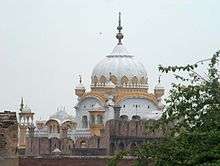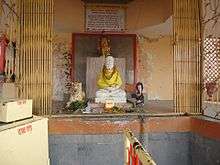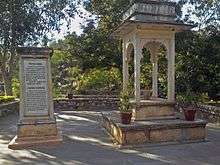Samadhi (shrine)
Samādhi or samadhi mandir is the Hindi name for a temple, shrine or memorial commemorating the dead (similar to a tomb or mausoleum),[1][2][3] which may or may not contain the body of the deceased. Samadhi sites are often built in this way to honor people regarded as saints or gurus in Hindu religious traditions, wherein such souls are said to have passed into mahāsamādhi, or were already in samādhi (non-dualistic state of consciousness) at the time of death.


Samadhi is also used in Sikhism for the mausoleums of eminent figures, both religious and political. Examples include the Samadhi of Ranjit Singh in Lahore, and that of Maharaja Sher Singh near Lahore. Hindu equivalents are usually called chatri, although those for Maratha Empire figures also often use "samadhi".
The forms of structure called "samadhi" vary greatly. The word is sometimes used for a memorial stele, also called paliya, a type of hero stone once common in parts of Gujarat and Sindh. It may be used for small memorial buildings such as open chatri, often placed around a temple.
The tradition of India is cremation for most Hindu people at the time of death, while samadhi is generally reserved for very advanced souls, such as yogis and saints, who have already been "purified by the fire of yoga"[4] or who are believed to have been in the state of samadhi at time of death. Samadhi may not involve cremation.
Examples
One of the popular site of pilgrimage in India is the town of Alandi in the state of Maharashtra where the 13th century Varkari saint Dnyaneshwar took Sanjivan Samadhi or entombed himself in the state of Samadhi. His devotees believe that he is still alive.[5][6]
A. C. Bhaktivedanta Swami Prabhupada (d. 1977) the founder of ISKCON (known as the "Hare Krishna Movement"), is commemorated with a large Samadhi Mandir in Mayapur, West Bengal.
- Samadhi of the Maratha admiral Kanhoji Angre

 Samadi with image, Maharashtra
Samadi with image, Maharashtra Samadhi of Jijamata, the mother of the Maratha emperor Shivaji, Pachad, Raigadh, Maharashtra
Samadhi of Jijamata, the mother of the Maratha emperor Shivaji, Pachad, Raigadh, Maharashtra Memorial to Chetak, a horse who died in battle in 1576
Memorial to Chetak, a horse who died in battle in 1576- Samadhi memorial for a royal dog, Raigad Fort
See also
References
- "Hindi dictionary (Samadhi)". Retrieved 18 September 2014.
- "Oxford Dictionary - American English". Retrieved 18 September 2014.
- "Oxford Dictionary - English". Retrieved 18 September 2014.
- Georg Feuerstein, The Encyclopedia of Yoga and Tantra (Boston: Shambhala Publications, 2011 ), p. 308.
- Novetzke 2009, p. 218.
- Glushkova 2014, p. 116.
Bibliography
- Glushkova, Irina (2014), Objects of Worship in South Asian Religions: Forms, Practices and Meanings, Routledge, ISBN 978-1-317-67595-2
- Dallmayr, Fred (2007), In Search of the Good Life: A Pedogogy for Troubled Times, University Press of Kentucky, ISBN 0-8131-3858-2
External links
| Wikimedia Commons has media related to Samadhi (shrines). |
| Look up samadhi in Wiktionary, the free dictionary. |